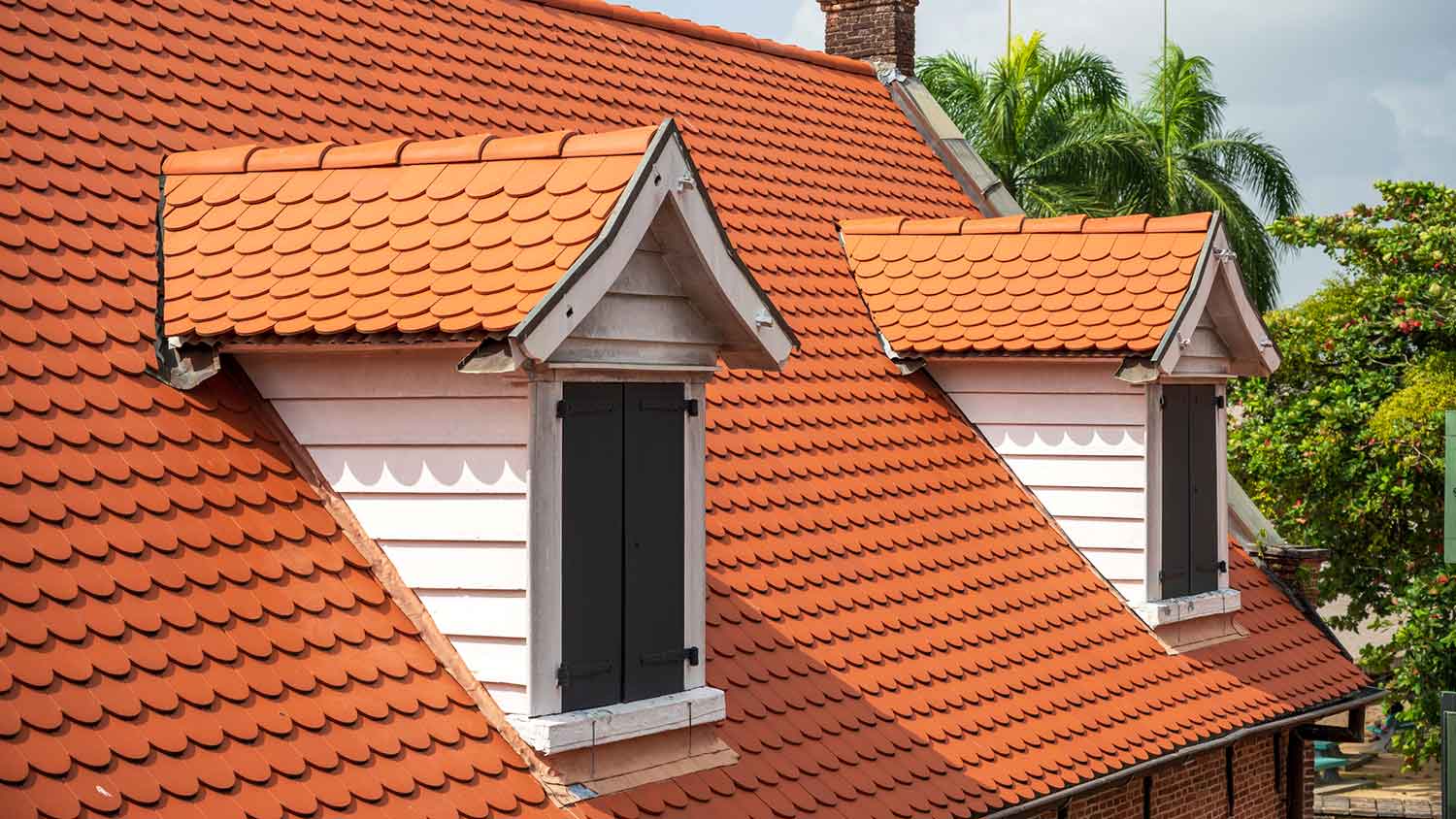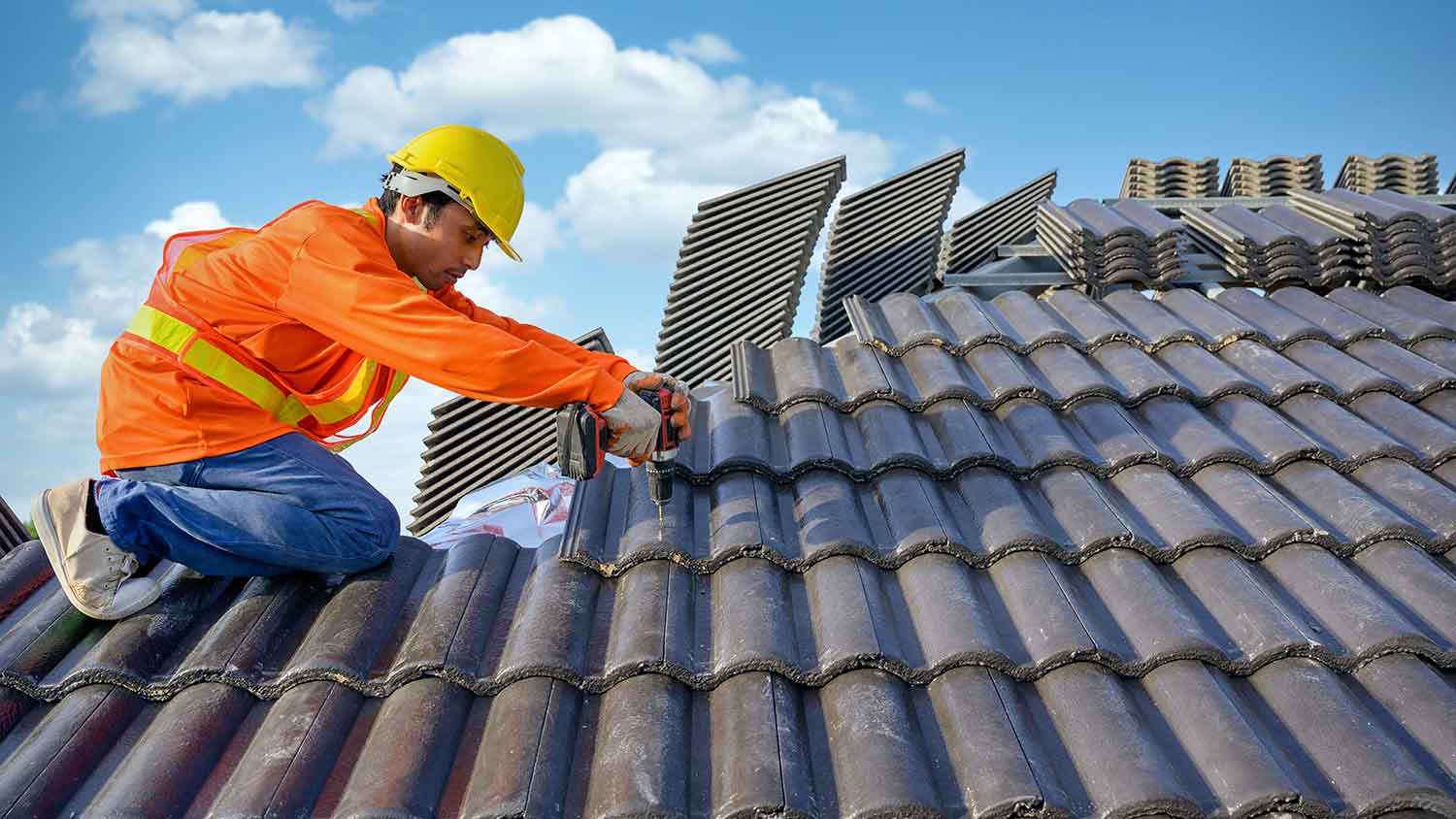Clay vs. Concrete Roof Tiles: What’s the Difference?
Get a concrete answer about the best roof tiles for your home


Clay roof tiles last about twice as long but also cost twice as much as concrete tiles.
Clay and concrete are both sustainable roofing options.
Concrete roof tiles are more customizable than clay when it comes to color, shape, and size.
Clay and concrete roof tiles are both great alternatives to traditional asphalt shingles, as both provide a unique appearance and much better longevity. When deciding between the two, it’s important to consider upfront cost, durability, color options, appearance, and more. In this article, we’ll explain the differences between clay and concrete roof tiles to help you decide which material is best for your roof replacement project.
Clay vs. Concrete Roof Tiles: Key Differences
Clay roof tiles are more expensive than concrete tiles, but they provide a more natural appearance and old-world charm. They have a few key benefits, most importantly, double the life span. Concrete roof tiles can be about half the cost of clay roof tiles and are more customizable, but they don’t last as long. Both materials are sustainable when it comes to recycling and the insulation they provide.
What Are Clay Roof Tiles?

Clay roof tiles are made out of baked clay, which comes from the soil. Manufacturers can make tiles of different shapes and sizes to offer some design customization, but they only come in natural earth tones.
| Pros | Cons |
|---|---|
| Last up to 100 years | Expensive |
| Excellent insulation | Few colors |
| Beautiful appearance | Cracks are obvious |
Best for: Homes in hot climates and homeowners looking for maximum roof longevity
Pros of Clay Roof Tiles
One of the most impressive upsides of clay roof tiles is their life span. With proper care, a clay roof can last for 100 years or more. They might cost more upfront, but the longevity you get is likely to make clay roofs less expensive in the long run than most other options.
Clay roofs excel in hotter climates, especially for homes in direct sunlight. Clay tiles have an air gap between the tile itself and the roof deck, making it harder for heat to transfer to your home. Clay also naturally has a light coloration, which helps reflect sunlight, further reducing heat transfer.
Clay roofs have been around for thousands of years, so they provide a lot of charm and natural beauty. Homeowners who want their house to stand out a bit will likely adore clay roofs.
Cons of Clay Roof Tiles
The most significant downside of clay roof tiles is the upfront cost of roof replacement. While they last much longer than asphalt and concrete roofs, they cost between $3 and $7 per square foot for the materials alone. Terracotta tiles cost even more, at up to $10 per square foot. For comparison, concrete roof tiles cost between $2 and $4 per square foot.
Clay tiles only come in natural earth tones and a handful of standard shapes and sizes, so customization options are limited. Finally, clay tiles are durable, but if they crack, it’s very obvious from the street.
The many factors that play into choosing a roofing material may surprise you, such as durability, cost, style, and the climate in which you live. Many homeowners choose asphalt, but there are various types on the market. A roofer can advise you on the best materials for your home and region.
What Are Concrete Roof Tiles?

Concrete roof tiles are made out of cement, aggregate, and water, much like the concrete that makes up sidewalks, walkways, and driveways. Contractors and manufacturers can color and custom-make concrete roof tiles, meaning you have virtually unlimited options for your roof’s final appearance.
| Pros | Cons |
|---|---|
| Last for 50+ years | Extremely heavy |
| Highly insulative | Expensive |
| Customizable | Damage is obvious |
Best for: Homeowners who want a customized roof, as well as those who want good longevity with a lower upfront cost
Pros of Concrete Roof Tiles
The most appealing part of choosing concrete tiles over clay roof tiles is the upfront cost. Concrete tiles cost around half as much as clay tiles, although they’re still more expensive than asphalt roofing. The value you get is about the same as with clay roofing, as concrete tiles cost about half as much and last for about half as long, so they’re a great way to keep upfront prices to a minimum.
Concrete roof tiles provide similar insulation to clay tiles, making them a more popular option in hotter climates where solar heat gain is more of a concern. They come in a virtually unlimited variety of shapes and colors, which not only means more customization options but also the opportunity to choose a more reflective color than clay.
Cons of Concrete Roof Tiles
Concrete roof tiles might be less costly than clay, but they’re still about twice as expensive as asphalt roofing. Concrete tiles cost between $2 and $4 per square foot, whereas asphalt shingles sit between $1 and $2 per square foot.
Concrete roof tiles are among the heaviest types of roofing materials, so they’re the most likely to require structural reinforcements prior to installation. Clay tiles are also heavier than asphalt shingles but not quite as heavy as concrete.
Finally, damage to concrete roof tiles is also going to be obvious from the street, so you’ll likely want to make repairs quickly both to prevent leaks and to maintain good curb appeal.
Clay vs. Concrete Roof Tiles
There are a few key areas to compare clay and concrete roof tiles to decide which is the best option for your roof.
Appearance: Tie
Both clay and concrete roof tiles can add beauty and intrigue to your home. They each come in a variety of styles to make your home unique, and both types of roof tiles can add a natural and charming look to your structure.
Customization: Concrete
Concrete tiles come in a wider variety of colors, shapes, and sizes, giving you more room to customize to suit your preferences. You can go for an earthy tone like you’d get from clay tiles, but you can also have your roofing professional dye the concrete for a totally unique color option.
Cost: Concrete
Installing clay tile roofs can cost twice as much as concrete roofs, totaling between $3 and $10 per square foot as opposed to the $2 to $4 per square foot you’d pay for concrete tiles. With that said, clay roofs last about twice as long, so the value you get for the money is about equal.
Weight: Clay
Both clay and concrete roofs weigh far more than asphalt shingles, but concrete remains one of the heaviest roofing materials. It’s more likely to require structural repairs before installation, which could drive up installation costs. You might also need to pay for a structural engineer’s inspection to confirm your structure can support the added weight.
Longevity: Clay
Clay roof tiles can last for 100 years or more, while concrete roofs top out around 50 years. Both are more durable than standard asphalt roofs, but for maximum longevity, clay is clearly the better option.
Insulation: Tie
Clay and concrete roof tiles both absorb and release heat slowly, reflect a good amount of sunshine, and have an insulative layer of air between the roof deck and the tiles themselves. These factors all contribute to better insulation than you’d get from an asphalt roof, particularly in hot, sunny climates. Clay is technically a bit more insulative, but concrete comes in lighter colors that can be more reflective, so they’re about even overall.
Ease of Repair: Tie
Repairing either a concrete or clay roof tile often requires removing and replacing it entirely. The work is about equal between the two roofs, and both repairs are best to leave to a professional roofing company near you.
Maintenance: Clay
Clay and concrete roofs are mostly low maintenance, but since concrete tiles absorb water more readily, you’ll have to seal concrete tiles every three to five years. Clay will naturally remain water-resistant for its life span and doesn’t require sealing. You might also notice algae and mold growth on concrete roofing if you don’t seal it regularly, which requires roof cleaning.
Sustainability: Tie
Clay and concrete are both natural materials and recyclable. According to the Environmental Protection Agency (EPA), concrete is recycled more often, although this likely has to do with the available avenues for recycling due to concrete being a more prevalent building material overall. When comparing both types of tile roofs to asphalt roofs, clay and concrete are considered more sustainable.
Resale Value: Tie
Clay roofs will provide better resale value than concrete roofs, as they last twice as long. However, the overall return on investment (ROI) is about the same, as clay costs about twice as much. Both roofing options are expected to provide better resale value than standard asphalt roofs.





- Roofers
- Metal Roofing
- Roof Repair
- Roof Inspection
- Vinyl Siding Repair Contractors
- Flat Roofing Companies
- Commercial Roofing
- Emergency Roofing Companies
- Leaky Roof Repair
- Metal Roof Repair
- Business Roof Repair
- Flat Roof Repair
- Tile Roof Repair
- Slate Roofers
- Rubber Roofers
- Roofing & Siding
- Metal Roof Installation
- Affordable Roofing
- Roof Sealing
- Attic Ventilation Contractors










